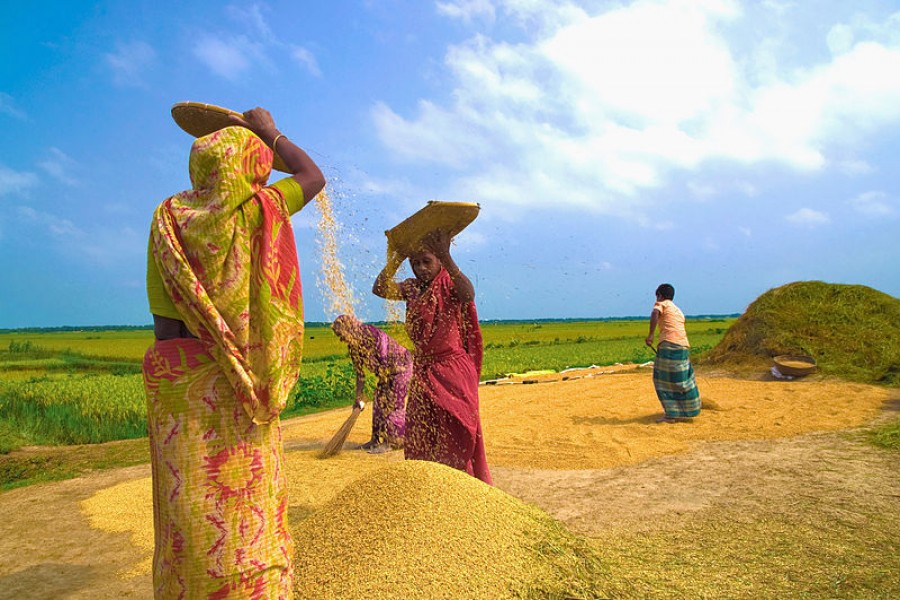An agrarian festival, Nabanna was on the wane with the changing crop pattern of the main staple paddy or rice. The traditional Aman, Aus and Deegha (early variety before Aman) paddies are no longer cultivated in many areas of Bangladesh. With IRRI and Boro replacing those as the main crops, Nabanna has been relegated to the back burner. But the demise of such a secular festival in the rural areas cannot be accepted. Credited with baro mase tero parbon (13 festivals in 12 months), the Bangalees will culturally be poorer indeed if they have to say good bye to this wonderful festival.
On its own Hemanta is a dusky and gloomy season heralding the winter. There is no such season on the Gregorian calendar. People in the West will never learn to appreciate Hemanta as immortalised by Jibanananda Das. The duskiness that envelops the surroundings with the sunset and the dew drops hanging from grass blades in the morning has an unexplainably ethereal quality. The season used to coming alive with Aman harvesting. That was a time when not only the rural economy but also the country's economy was mostly dependent on agriculture with paddy providing food for the nation and jute fetching hard cash. Wheat had virtually no place in Bangalee dishes.
It is only natural that the farming community accorded a special recognition to harvesting for much of their weal and woes depended on good or bad harvest. But people in ancient time -either in Greek, Rome or in this part of the world -- cherished in their bosom a hope that the deity or gods would give them bountiful of crops if they revered the former and celebrated the occasion in as appropriate a manner as it demands. The Bangalee Hindus thus worshipped Laxmi, the goddess of wealth, and a special dish was offered to her with rice husked from specially selected sheaves of paddy collected from field. The tradition is still maintained albeit on a low key.
The rituals varied in different regions of undivided Bengal. For example, there is still a custom of offering prayer to ancestors with newly harvested and cooked rice. Some do it with sweetened rice and others offer cooked rice with varieties of curries. The celebration gradually took different forms with the concentration on turning the occasion into a feast. In the past, in some areas as many as forty dishes were prepared in order to have a sumptuous lunch or dinner. Indigenous cakes of various kinds with newly harvested rice powder were an additional attraction. This was further complemented by an offer of gifts including new dress to children.
Here is a picture of a prosperous society. But historians do not always agree with such social affluences in Bengal of the past. Let this be what it may. There is however no doubt about the festival gradually assuming a secular character over time. Communities other than the Hindus also did not want to miss an occasion as important as harvesting without celebration. They realised that the fresh grains have an overriding significance in their struggle for survival and financial position. Months prior to harvest were hard time and the new crops arrived with the message of renewal of life. Their living standard and financial status revolved around the amount of paddy they could store in their granaries.
So the Bangalees irrespective of their caste and creed started celebrating Nabanna. Newly harvested rice took the centre stage of the celebration. Preparing special dishes of staple and cakes made from rice became an order of the day. This certainly had to be complemented by as many delicious curries as possible. Thus the secular character of the festival evolved only to fade out with the arrival of hybrid paddies which are harvested at different times, not in Agrahayan the month known for Aman harvesting.
It is against this backdrop, a committee has been formed in the capital with the aim to resuscitate this fading culture and custom. It has been arranging elaborate programmes on Nabanna at the premise of the Faculty of Fine Art, Dhaka Universty for about a decade now. The celebration focuses on different rural art forms including songs, dance and indigenous sports. This certainly is a highly commendable initiative because under the influence of alien culture, this country's traditional ways of life and culture are now mostly cornered.
With time there is need for reordering and rearranging the folk culture so that the invasion of pernicious alien culture with an overdose of obscenity and sensuality as against sensuousness cannot overwhelm the land's mooring. Nabanna is one such occasion that has arisen out of this soil and if presented with some remodelling, this can be equally welcome like Pahela Baishakh to all including the urban people. Now that people in rural areas have access to modern gadgets, it will not be easy to turn them back to their cultural roots unless the various forms of traditional folk art are presented in new formats. Fairs can be arranged on the occasion of such festivals to promote and reward local artistes. Kabi gan (competition between kabis of extempore rhymed songs), Jatra and many other forms of folk art deserve to be revived in order to reawaken the rural population from cultural eclipse.


